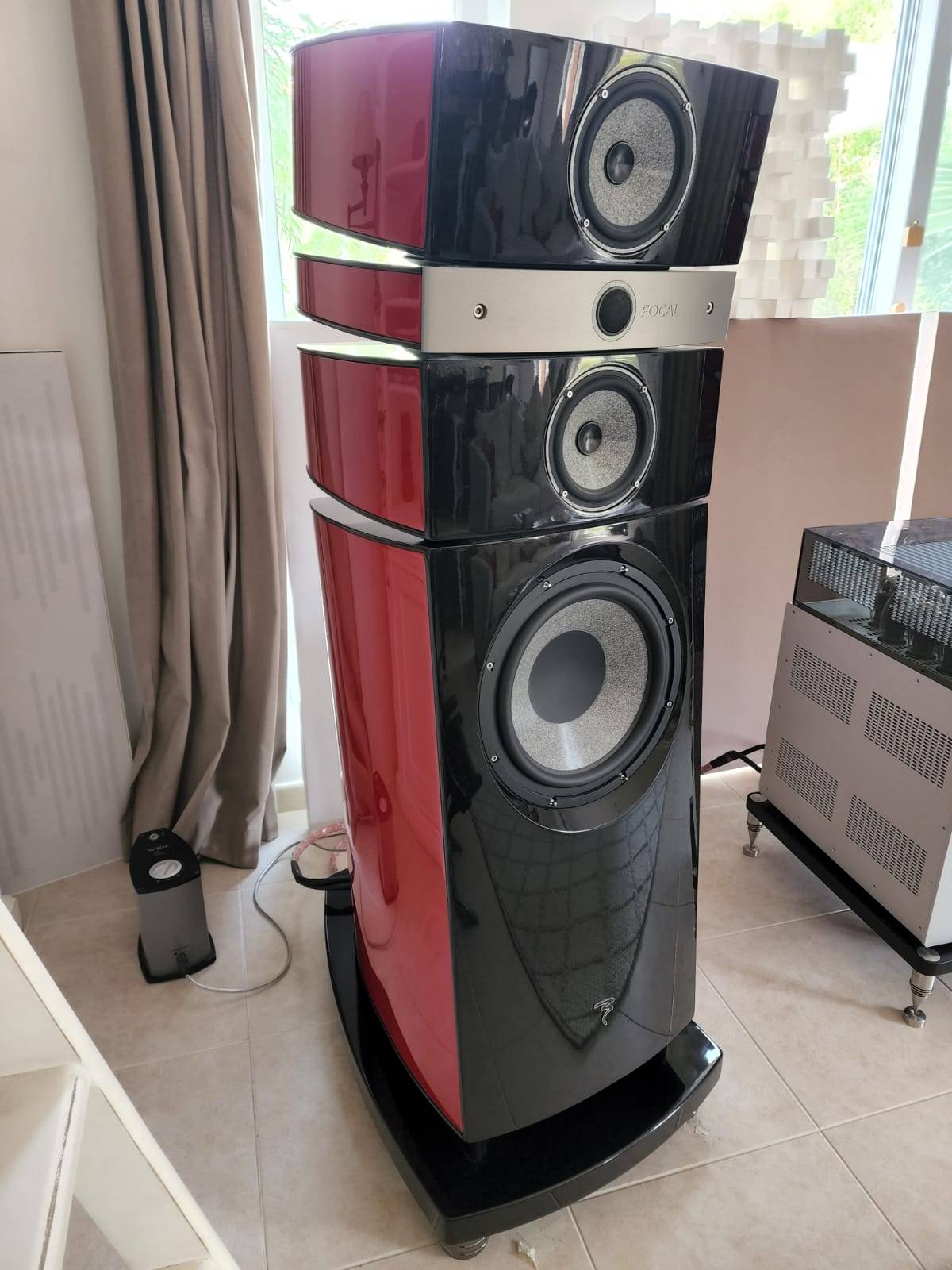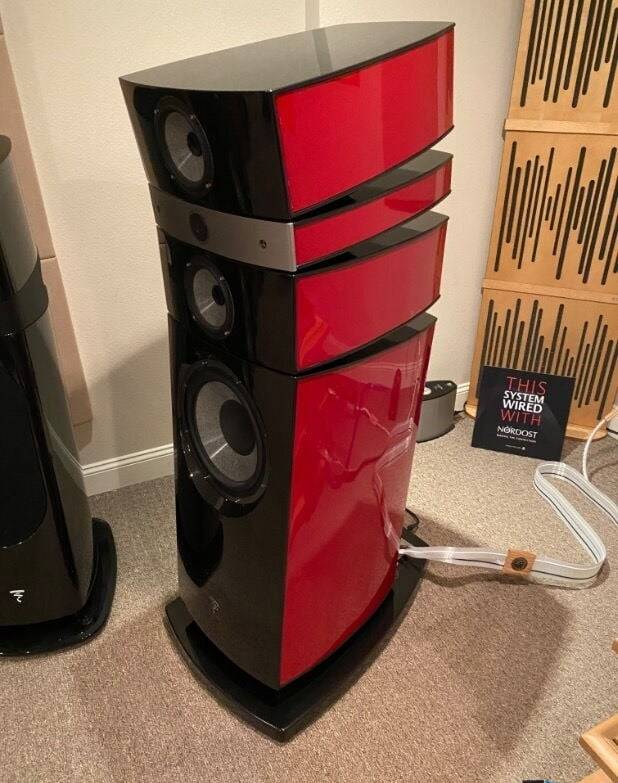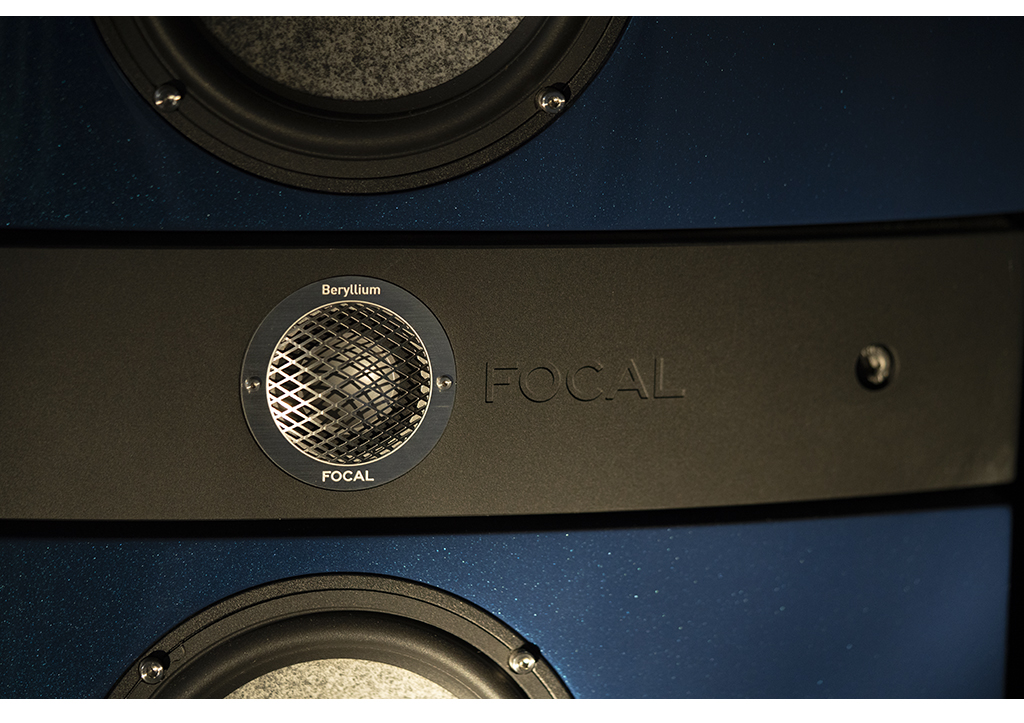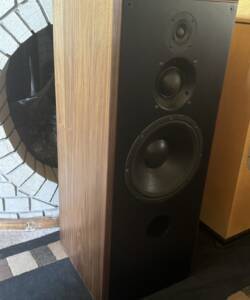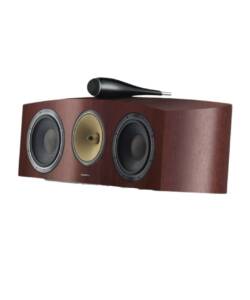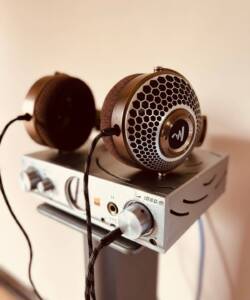Focal Stella Utopia EM
Original price was: R1,850,000.00.R980,000.00Current price is: R980,000.00.
Stella Utopia EM
Real technological twin sister of the Grande Utopia EM, the Stella Utopia EM floorstanding loudspeaker has absorbed the gist of the most outstanding innovations, in a 3-way version and with more convenient dimensions. The new 13″ (33cm) built-in W woofer works with the same electro-magnet as in the Grande Utopia EM, which is as well efficient in the infrabass as in the midbass. A major innovation that makes you rediscover all the dynamics and definition in a critical frequency response that’s totally brought to light by the Stella Utopia EM audiophile acoustic hifi loudspeaker.30 years of “the Spirit of Sound”
since 1979, focal is one of the world leaders of the high-end acoustic loudspeakers. 30 years to fight for our values, to keep our production in france and to stand up for the idea of a luxury “à la française”. innovation, tradition, be the world’s best in everything we create for your pleasure, that’s our philosophy: “the spirit of sound”.
The world’s best
all our loudspeakers are made according to the same quality standards to offer the best listening solution whatever the size or price. so, what’s the difference between a worldwide reference loudspeaker grande utopia em and a multimedia system focal xs? between this infinitely tall and this infinitely small? in the end, the difference’s not that big…
Tradition
the traditional loudspeaker and the driver are the historical channels of focal, the heart of its dna, made of technologies, mechanics and noble materials. but that’s also an object that’s part of our everyday life. that’s why we took much care about each detail…
Innovation
innovating is pushing the envelope. focal permanently invents new solutions to integrate a quality sound whatever the conditions, in-wall, on-wall or in-ceiling loudspeakers. and everything becomes possible…
Pleasure
listening to your music everywhere in your everyday environment, it’s now possible. focal has the solution to bring a quality sound in any rooms: the living-room, bedroom, hall, kitchen or even the bathroom. even outside with the outdoor range, waterproof and resistant to all kinds of weathers. for a great listening pleasure everywhere.
Evolution axis of transducers
The first meetings, with our driver and filtering engineers consisted in sweeping over the progress potentials in terms of transducers.
Tweeter
If Beryllium has never been questioned, very soon we agreed that a new magnet should be designed in order to take advantage of a better decompression by a totally cleared profile. The experience gained with the “IAL” tweeter developed for the Electra 1000Be range had already brought evolution ideas for, on the one hand, raising the magnetic field and on the other hand, extending the frequency response in the low range. The challenge was simple: win efficiency and increase the dynamic capacity as well as power handling.
Woofer and mid-bass
In a passive system, these 2 transducers set the loudspeaker sensitivity. If the 11” mid-bass speaker should progress, being a limitation point in dynamics of version II (Be) of 2002, the key point concerned the 15” woofer. The challenge with version III of 2008 was to bring a decisive evolution in the bass, in the image of the technological step brought by Beryllium in 2002 in the treble. The requirements straightaway fixed 2 demands: efficiency increase and possibility of level adjustment in order to be adapted to the acoustics of the listening room. An active solution offered advantages, even better, an AES publishing of May 2004 dealing with a dipole system that forms a cardioid source, was appealing in terms of coupling with the different kinds of rooms. However, after a pre-study, this choice required – to be precise – to resort to a source of 2 speakers independently driven and digitally treated in order to create an adjustable directivity scheme, which represented a decisive advantage in terms of adaptation. The study promised to be arduous and complex… Moreover, it could have an impact on the design depending on the use of two 13” speakers instead of one 15” speaker or even one 18” speaker.
Midrange
During the last 2 years, we tested new materials for the cones. Could we do better than the last W evolutions? We set ourselves 6 months to finalize a choice concerning the cone. We also began working on the spider and surround. At last, improving again the performance steadiness in production, in the ear high-sensitivity zone, made up another work axis.
Crossover
Besides a state of the art valuation in terms of passive components (copper-foil inductor, wire type…), capacitors (electrodes, dielectric, envelope…) and resistors (self-inductance…), the choice of the internal wiring had also to be considered by a series of blind tests. However, concerning the crossover, a key point had to be satisfied: offering fine tunings so that the dealer can step in during the installation in order to optimize the performance (reverberation time of the room, customer taste, adaptation to other equipments such as electronics, cables…)
Design requirements
The first design meeting took place in Paris on October 13th 2005 in the design cabinet Pineau & Le Porcher premises… The goal: find the DNA of version III. The list of the initial constraints was as follow: Focus Time, separate midrange blocks and limitation of diffraction effects, 18”, 15” or 2×13” woofer, Tweeter Be at ear height, streamlined vent tube to avoid turbulence, the setting device on the back of the midrange compartment, possible cardioid woofer in an active system. The conclusions of these first exchanges were clear, the Utopia III DNA should lean on two dimensions; the Focus Time and the separate blocks for each transducer.
SPECIFICATIONS
Tweeter: Single – 1” dome
Midrange: Dual – 6” carbon fiber cone
Bass: Dual – 12” poly cone
Frequency Response: -3dB @18Hz – 24,000Hz
Efficiency: 88dB
Impedance: 8 Ohms nominal, 6 Ohms minimum
Footprint: 15” x 18” x 44” H
Weight: 81.7 kg (180lbs) / speaker
Description
This was “only” $90000 on special!!
If you’ve experienced Focals’ Grande Utopia Ems in a large room, set up to perfection, it’s easy to see why many consider them one of the (if not the) world’s finest loudspeakers.
But like a hyper sports car, they need a lot of space to give their all. And if you’ve ever heard the Grande’s and not been wowed, they were either set up poorly or in too small of a room. Their well over $200k/pair price and size requirements limit them to a small audience.
The $100,000 less a pair of Stellas cost should be enough to buy a system to go with. Still not for the less than well funded, but the difference between a $500k or closer to $1M system is often a very different customer, with other requirements. As someone once told me, “the difference between me, and my friends with big, big money is the jet. I fly first class, they have their own plane. We stay in the same five-star hotels and golf at Pebble, but they have the plane. Me, I walk to work, but I get it.
So, if you’re on board, and shopping speakers in this price range, there are some exciting choices. Where 10 or 15 years ago, this would be the stratosphere, it is now first class. (at least in terms of price) I submit that those having a somewhat smaller listening environment can achieve nearly the same result with the Stellas. However, the Stellas still need a fair amount of room to sing. Much like the MartinLogan Neoliths, we reviewed a few years back and the Sonus faber Aida, these speakers all taxed the limits of my listening room, which is only 16 x 24 feet. To be fair to Focal, I would suggest that this is the smallest room to achieve greatness with these speakers.
Any less listening space and you would probably be better served with the next speaker down the range, the Maestro Utopia. When we had the Maestros here, they were much easier to optimize to our room, but the Maestro lacks the field coil woofer and the wide range of adjustments making fine-tuning them to the ultimate degree that the Stella possesses. Choices can be tough.
The Stella does share the same field coil technology as the Grande, though in this speaker, the woofer is a 13-inch unit, instead of the 16-inch one in the Grande. Either way, the Stella still goes down to 22 Hz, so there really is no need for a subwoofer. This is a true full range speaker. Long term TONE readers know we like the low frequencies, and whether listening to a full orchestra, or the heaviest beats, the Stellas can rattle your listening room.
You will need Jedi-like patience
First, make sure and have help unboxing your Stellas. They weigh just a bit over 600 pounds each in their sturdy crates, and 374 pounds each, unboxed. Removing them is very straightforward, and in this case, Focal is at the top of their class compared to a few other large speakers we’ve used. Once unboxed, they are temporarily mounted on wheels, so once your assistants have them on the listening floor, the rest of the process is a breeze. Usually, the long wall in our main listening room is the go-to position, but in this case, placing the Stellas on the short wall, with the tweeters about five feet out from the rear wall proves perfect. There are two sets of adjustments for the low frequencies – the first tips up the bass response at about 50 Hz, in increments from a flat position, and the second increases or decreases the output of the woofer. A single set of jumpers increases midrange level and there are two settings for the tweeters, also adjustable via beefy jumpers, with a chart on the back of the Stellas, accessed by clicking the rear panel behind the tweeter.
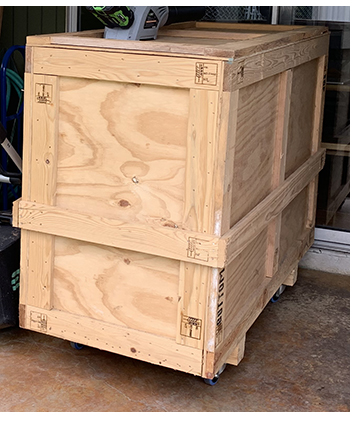 This degree of adjustment will either make you super happy or drive you to insanity. We felt it makes a speaker this good, so much easier to implement, and also is part of what makes the Stellas unique in their own right. Focal claims 243 unique adjustments. I probably tried 30 before I got to a level of extreme happiness.
But don’t get too crazy with adjustments just yet. Here’s the only bit of bad news concerning these speakers – they take a long time to break in all the way. Some say it’s close to 1000 hours. They sound flat, forward, and constricted out of the crates, but don’t despair. They start to open up between 100 and 200 hours, really coming into their own at about 400, with marginal improvements in clarity and smoothness going forward. As I recall our reference Sopra no.3s took a few hundred hours to sound their best too. Some of this is the woofer surround, some the beryllium tweeter, and the rest the electronics in the woofer power supply and crossover.
This degree of adjustment will either make you super happy or drive you to insanity. We felt it makes a speaker this good, so much easier to implement, and also is part of what makes the Stellas unique in their own right. Focal claims 243 unique adjustments. I probably tried 30 before I got to a level of extreme happiness.
But don’t get too crazy with adjustments just yet. Here’s the only bit of bad news concerning these speakers – they take a long time to break in all the way. Some say it’s close to 1000 hours. They sound flat, forward, and constricted out of the crates, but don’t despair. They start to open up between 100 and 200 hours, really coming into their own at about 400, with marginal improvements in clarity and smoothness going forward. As I recall our reference Sopra no.3s took a few hundred hours to sound their best too. Some of this is the woofer surround, some the beryllium tweeter, and the rest the electronics in the woofer power supply and crossover.
Here’s another Stella tip to save you major disappointment. If you’ve never owned a Focal speaker, their factory in France takes great care to put a tightly adhering, clear plastic wrap on the speakers, so they survive the boat ride. However, in our case, the friendly folks at Focal wrapped over the midrange drivers, so there was almost no output. Everyone was sitting around after unpacking going “damn these speakers have no midrange to speak of,” but it was our fault for not double-checking. Remove the black grills and make sure the drivers are uncovered!! Plan on it taking about a months’ worth of solid listening until your Stellas sound as they should, don’t give up on them!
Incredibly easy to drive
Thanks to the field coil woofer and the rest of the tech inside the Stellas, they have a sensitivity rating of 94db. This sounds good on paper, but some efficient speakers have a lot of crossover network loss, and still need a massive amplifier to really make a lot of sound. Even the 4 watt per channel Whammerdyne 2A3 delivered heavenly results with the Stellas, though that’s probably not quite enough juice in a large room.
Realistically, 30 watts per channel will get the job done, and the emphasis should be on quality here. Working with the Pass XA30.8 (30wpc), our Nagra 300B (25wpc), the VAC Sigma 170i(80wpc) and the new Conrad-Johnson ART 27 (36wpc) all were brilliant choices. For those having more power on tap, you will get even more dynamic swing. Cycling through the Pass XA200.8s, a pair of Nagra Classic Monoblocks, the Audio Research 160Ms and the latest EVO400 monoblocks from PrimaLuna were like going from a 600cc motorcycle to a 1000cc bike, and thanks to the incredibly high resolution that the Stellas offer, each of the dozen amplifiers we auditioned the Stellas with offered a completely different listening experience. So there is plenty of fine-tuning to be done there as well.
But the key to Stella’s superiority is break in and setup. Once you have a rough set performed, plan on spending the better part of a day really fine-tuning your Stellas for best results. As I’ve said many times before, it’s like correctly optimizing VTA on a premium phono cartridge. When you get it just right, these big speakers disappear into your listening space like a pair of LS3/5as – it’s an experience to behold. If they sound harsh or bright, your work is not complete. Pay particularly close attention to the rake angle of these, once you’ve optimized position for the best balance of bass extension and lack of mid-bass bloat. Then make small (I mean tiny) changes on the rake angle to get the tweeter position just right. Consider those controls on the back as your last resort. I didn’t need them in my main listening room, but they were a major blessing in my 14 x 18-foot living room.
As your Stellas break-in, you’ll be starting to really get a feel for what they can do. Great as the Sopras are, in comparison, they lack the degree of resolution and clarity that the Stellas offer. Going back and forth between the Stellas, Sopra 3s, and Kanta 3s, the lineage is clear – you would never mistake the other two speakers for anything but Focal, but the sheer ability to move air and swing is what makes the Stellas worth their considerably higher price tag. You just don’t get this in a 20-50k speaker. Think those audiophile clichés of “lifting the veil,” “cleaning the window,” that kind of thing.
If you like the sheer speed of electrostatic speakers, Focal’s beryllium tweeter will not disappoint you. These speakers paint a big canvas, and while I always joke that you need big speakers to make big sound, you just don’t get this level of reach out and touch it with a pair of mini-monitors. Listening to Alan Taylor’s version of “The Tennessee Waltz,” and the banter of the musicians in the studio is scarily lifelike, reproducing every bit of nuance, that you’d expect from a minimalist singer/songwriter with an acoustic guitar in a small room. It doesn’t feel like an excellent recreation, it feels like you’re sitting on a stool in the studio, immersed in the performance. When using the big Pass monoblocks, AC/DCs “For Those About to Rock” can be played loud enough without distortion, compression, breakup, or collapse in the soundstage to approach the sheer sonic velocity of a live performance. This is where the 94db/1-watt sensitivity really comes in handy.
Small, single driver, high sensitivity speakers are entertaining, but they don’t play big music in a big way. And this is really the value proposition of the Stellas – they can render everything from the most intimate vocal performance to arena rock. All the while keeping it in perfect scale and perspective. Few speakers can do this, yet the Stellas do it without effort.
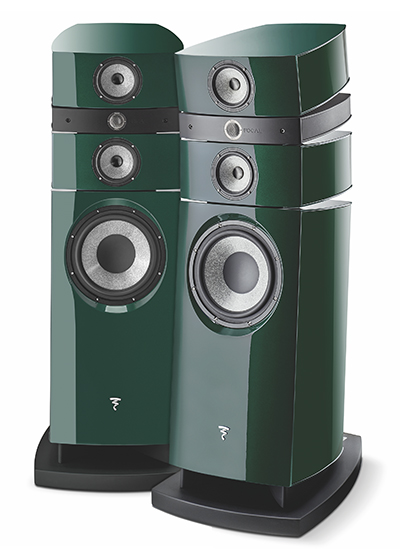 An incredible destination, indeed
An incredible destination, indeed
We could go on and on about all the tech that goes into the Stellas, but you can read about that here…
Focal goes into great depth about their current beryllium tweeter, the latest driver suspension, the EM woofer and their new power flower midrange drivers. The triumph is that it all works well and works together perfectly.
Having visited the Focal factory, and watching the incredibly skilled people that work there build these speakers is a true experience. Everything in the Stellas is designed and built from the ground up. All the drivers, the crossover networks, and the cabinets. I’ve mentioned this in past Focal reviews, but what I found most impressive about the Focal factory is the way they integrate modern and legacy techniques in building their speakers. In one room, you observe someone in a cleanroom wearing a hazmat suit stamping tweeter domes, yet in another, someone is sanding a coat of the cabinet’s final finish manually, stopping to feel the corners with a bare hand. All of this takes time, patience, and skill. While some will obviously balk at the price of the Stellas, you could pay this kind of money for a timepiece. The Stellas (and the Grandes) are really bespoke loudspeakers, and to me, musical works of art. I can’t help but comparing the Stellas to a fine automobile again, because when you drive top range sports cars, Ferrari does it one way, Aston Martin another, and Porsche still another. All deliver frighteningly good performance, yet you will respond to one of the three more than another. Mega speakers are the same way.
Yet putting it all in perspective, and that’s kind of a wacky thing for speakers that cost a lot more than most cars, the Focal Stella EMs deliver amazing performance. Take your breath away performance.
Focal Stella Utopia EM
EXCELLENCE AND DYNAMICS
THREE-WAY FLOOR LOUDSPEAKER
—
You will never hear your music like you did before… Real technological twin sister of the Grande Utopia EM, the Stella Utopia EM floorstanding loudspeaker has absorbed the gist of the most outstanding innovations, in a 3-way version and with more convenient dimensions. The new 13″ (33cm) built-in W woofer works with the same electro-magnet as in the Grande Utopia EM, which is as well efficient in the infrabass as in the midbass. A major innovation that makes you rediscover all the dynamics and definition in a critical frequency response that’s totally brought to light by the Stella Utopia EM audiophile acoustic hifi loudspeaker.
To give audiophiles the greatest pleasure, the Stella Utopia EM loudspeaker features a 13″ (33cm) ‘W’ cone woofer and the Grande Utopia EM’s Electro-Magnet, which proves just as efficient in the very low end as it does in the lower mid-range. This enables you to rediscover all the dynamics and definition of a frequency range which is entirely revealed by the Stella Utopia EM.
NEW MUSICALITY
—
Utopia III is a range of the very highest quality loudspeakers packed with cutting-edge technologies. With numerous innovations developed by Focal, our products in the Utopia III range have now neared perfection. They are able to cover the entire audio spectrum to provide flawless and dynamic sound, from low-frequency bass to the very high end. After the ‘W’ cone and the pure Beryllium inverted dome tweeter, the Grande Utopia was given an Electro-Magnet (EM) woofer delivering power which is incomparable with classic technologies. The incredible musicality of Utopia III promises access to a world of new emotions and sensations.
PACKED WITH INNOVATION
—
Since its launch in 1995, the Utopia range has been the driving force for Focal’s innovations: the ‘W’ cone, Focus Time, Multiferrite, Beryllium, Power Flower, OPC, Gamma Structure, to name a few… The Utopia III range was the proud heir of this highly technological heritage. Now, it has brought about the new revolution of the Electro-Magnet woofer, while optimizing the innovations it inherited.
A PURE DESIGN
—
The Utopia III range also represents an exclusive design for prestigious and unconventional loudspeakers. Through the brilliance and purity of their design, the shape of the loudspeakers in this range has been simplified as much as possible to eliminate anything superfluous.
Extraordinary performance and a unique style it isn’t just a technological monument, above all else, they are an acoustic sculpture.




